
As soon as people started to make homes – the earliest we know of are some 10,000 years old, in the Middle East and at Çatal Hüyük, now in Turkey – the need for housekeeping began. Although the links between dirt and disease would not be identified until centuries later, we know that early people swept their floors, washed clothes and had storerooms for food and specific areas for sleeping and cooking.
As homes evolved, living space changed from a single room or “hall” to a series of smaller rooms. By the 19th century keeping house had become a full-time occupation. For the better off it necessitated a plethora of servants, from housekeepers to laundry maids. Mrs Beeton’s Book of Household Management of 1861 provided sound advice, as did the growing number of other practical publications.
Thanks to electrical devices such as the washing machine and vacuum cleaner, the housework no longer takes all week, but we still share many of the problems of our grandmothers. Moths still chew our clothes, mice still invade our living space, windows still need cleaning. Despite the plethora of new products, many of the old remedies remain the most effective.
DE-SCALE A KETTLE WITH VINEGAR

The classroom chemistry of acid plus alkali is the secret behind this effective tip, which is sure to save you money on any expensive proprietary preparations. Lemon juice also works well in both kettles and showerheads.
Limescale, made primarily of alkaline calcium carbonate, is deposited as “fur” in your kettle (and dishwasher, washing machine and toilet) if you live in a hard water area. Dissolved calcium compounds separate out as the water is boiled, and eventually accumulate as solid lumps.
Among thieves, ‘kettle’ is slang for a stolen watch. A tin-kettle denotes a silver one, while a red-kettle is gold.
Vinegar, which is acetic acid (or lemon juice, which is citric acid) reacts with limescale and dissolves it. For bad scaling, fill the kettle with a mixture of malt or white pickling vinegar diluted half and half with water, bring it to the boil and leave it for a couple of hours or overnight. If any furring remains, simply repeat the process.
A small piece of wire mesh inside a kettle will collect “fur.” A similar old remedy is recommended by Enquire Within. To remove an “unpleasant crust,” it advises placing “a clean oyster-shell or a piece of stone or marble” within, which “will always keep the interior of the kettle in good order, by attracting the particles of earth or of stone.”
In the 1930s there was a vogue for drinking cider vinegar as an aid to weight loss. One medical condemnation declared, “The only way in which vinegar can make one thin is by seriously harming the digestion.”
USE LAVENDER TO KEEP CLOTHES MOTHS AT BAY
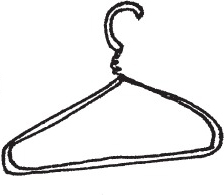
Lavender will keep your drawers and wardrobes smelling sweet, but as a moth deterrent it is not nearly as effective as some traditionalists would have you believe. For a natural choice, cedar oil is a better remedy, but is still far from totally reliable.
The clothes moth (Tineola bisselliella) is a menace. It lays its eggs on the fibres of clothes and carpets, where they hatch into larvae about ¼ inch (6 mm) long, which then plump themselves up by munching holes in your prized garments and furnishings. Wool is their favorite food, but they will also devour cotton and even leather and fur. The moths that hatch from the larvae don’t eat at all, but are ready to mate and restart the cycle.
In northern England clothes moths are sometimes known as ‘ghosts’. Killing one is thought to precipitate the death of a relative.
Camphor oil was the original ingredient of mothballs, but has been superseded by more powerful and effective chemicals, such as naphthalene and parachlorobenzene. If you use them, follow any instructions to the letter.
Cleanliness was, and is, the most effective way of protecting items from moths, which are particularly attracted to food and grease on clothes. Keeping woolens well brushed (skin flakes are additional food) will help them stay moth-free, and ironing may kill the eggs.
The 1920s housewife was advised to get rid of carpet moths by scrubbing the floor with “hot water made exceedingly salty before replacing the carpet, and sprinkle the carpet once a week before sweeping until the pests disappear.” The beating of rugs, a household duty now replaced by vacuuming, was a standard part of the weekly cleaning routine.

The ancient Egyptians kept cats in their granaries to kill mice and rats. Some 3,500 years on, felines are still effective against these household pests, although a really bad rodent infestation may require the intervention of a professional controller.
Cat versus mouse is a matter of instinct. A cat is “programmed” to chase and torment a mouse (or a fluff-filled replica or even a rolled-up pair of socks until it tires of the deception), and while a pet cat may present you with dead rodents as “gifts,” its untamed ancestors would have relied on these creatures for food. And although a cat will hunt during the day, at heart it is a night hunter, using its natural attributes of reflective eyes, acute hearing, sensitive whiskers, sharp claws and long canine teeth to detect and seize its prey. Cats also have the patience to wait for hours for their prey and to torment it until it is finally dead.
Mice rely for their evolutionary success on safety in numbers (ensured by rapid and persistent breeding), agility and an omnivorous diet that can even include newspapers and electric cables. They are also intelligent enough to work out how to avoid the most cunning mousetraps and all but the most tempting of chemical baits.
Because of their association with witches and the Devil, cats were routinely exterminated from the 13th century onwards. It is even possible that the Great Plague, which struck London in 1664, would not have happened if there had been enough cats available to catch the rats that transmitted the disease.
If you can’t or won’t keep a cat, try one of these methods of catching or deterring mice:
 Block up their exits and entrances, including the smallest gaps under doors, between floorboards and around pipes.
Block up their exits and entrances, including the smallest gaps under doors, between floorboards and around pipes.
 Smear mint toothpaste round the edges of their holes; the smell will deter them.
Smear mint toothpaste round the edges of their holes; the smell will deter them.
 Bait mousetraps with bacon, peanut butter or nut chocolate rather than cheese.
Bait mousetraps with bacon, peanut butter or nut chocolate rather than cheese.
 Put down proprietary mousekiller, but be sure to keep poisons away from food and children. Handle any deceased animals wearing rubber gloves.
Put down proprietary mousekiller, but be sure to keep poisons away from food and children. Handle any deceased animals wearing rubber gloves.
NEVER EAT A BOILED EGG WITH A SILVER SPOON
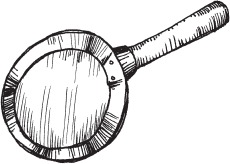
The quickest way to tarnish silver is to use it to eat an egg. Not only that, the reaction between the silver and the egg can create a foul taste in the mouth. Vegetables high in sulfur, such as cabbage, will also tarnish silver.
When silver comes in contact with hydrogen sulphide, the “bad eggs” gas that dissipates from a yolk forms blue-black silver sulphide, or tarnish. Washing up directly after a meal will help prevent tarnishing, and for taking a little tarnish off sterling silver the quickest and easiest remedy is to soak it in hot water to which you have added a teaspoon of dishwashing soap or baking soda.
For a high shine, you can buff silver with a cloth or a chamois leather, but this risks wearing away the coating of EPS or “silver plate.” To treat a heavy tarnish the experts advise against immersing silver in an acid “dip.” If used at all, apply it sparingly on a sponge soaked in the solution and wash it off in very hot water immediately afterwards.
A jeweler’s rouge cloth is the nearest modern equivalent to the old method of cleaning silver. In former times the rouge would have been bought as a powder and mixed with ammonia before use.
Sterling silver is 92.5 percent pure silver mixed with 7.5 percent copper to make a harder, more durable alloy. Silver plate is a thin film of silver electroplated on to an object made of base metal such as copper or a nickel alloy after manufacture.
DON’T DRY WET SHOES BY THE FIRE
Soaked leather, if dried quickly, will become brittle and cracked and develop white “tide marks.” The old way is still the best way: sponge wet shoes, stuff them with crumpled newspaper and leave them to dry slowly and naturally in the air.
There is nothing more frustrating than having a good pair of shoes ruined by rain or snow, and an old way of waterproofing them was to rub them with castor oil or petroleum jelly or with a mixture of beeswax and lard. Paraffin oil was added to boot blacking to protect and restore damp leather, while varnishing the soles of boots was said to “render them impervious to damp and make them last longer.”
To keep good footwear in shape, boot or shoetrees remain the best treatment, and a bespoke men’s shoemaker will still supply trees to fit shoes exactly. Suede that has become shiny can easily be restored by carefully rubbing it with fine sandpaper.
In the days before mass manufacture, leather boots and shoes were particularly valuable items. Durable clogs, with iron-shod wooden soles and leather or fabric uppers, were a cheaper and more hard-wearing alternative for most working people in Britain. In the Netherlands and other continental European countries, all-wood clogs were worn. In wartime Britain – and in post-war years when clothes were still rationed – it was commonplace for children to have a single pair of shoes for the winter from which the toes were cut to make “sandals” for the summer.
It is said that in autumn the best way to dry out damp shoes is to fill them with chopped horse chestnuts.
POLISH WINDOWS WITH NEWSPAPER
Rolled into a pad, newspaper is a good old-fashioned substitute for a polishing cloth or chamois leather, but it is by no means the only effective way to get the shine on your panes that was once essential to a good reputation. “Dirty windows,” it was said, “speak to the passer-by of the negligence of the inmates.”
Dirty windows not only deprive rooms of light but make them look unattractive. If you can, clean the windows on a dull day, or at least when the sun is not shining on the glass, to prevent streaks and allow you to see the results of your labors clearly.
Good modern cleaning choices are either washing with a solution of detergent or a proprietary liquid, or using a spray containing ammonia and alcohol, which then needs to be rubbed off with a soft cloth. The squeegee, used by the professionals, is an excellent – and some say the only – means of getting a sparkling finish on your windows.
Don’t forget the frames. Regular dusting helps to keep them free of dirt, but in winter it is also essential to remove any condensation that accumulates on them: as well as rotting wooden frames, it can be the breeding ground for unsightly black mildew.
Despite its name, chamois leather is not made from goatskin but from the underlayer or “split” of a sheepskin after the top layer of skin has been removed.
OLD WINDOW-CLEANING RECIPES
 Equal parts of paraffin and methylated spirits rubbed on to dry glass and polished off when dry.
Equal parts of paraffin and methylated spirits rubbed on to dry glass and polished off when dry.
 A bunch of stinging nettles dipped into water with a dash of vinegar added (wear thick gloves!). Dry the glass with a soft cloth or chamois.
A bunch of stinging nettles dipped into water with a dash of vinegar added (wear thick gloves!). Dry the glass with a soft cloth or chamois.
 Turpentine: especially good for grease marks.
Turpentine: especially good for grease marks.
 A solution made by pouring boiling water on a chopped potato.
A solution made by pouring boiling water on a chopped potato.
 Washing soda dissolved in water, with a little ammonia added.
Washing soda dissolved in water, with a little ammonia added.
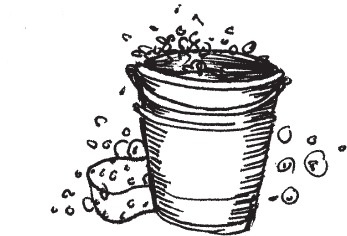
BEWARE OF ONE BAD APPLE IN THE BARREL
For the prudent housekeeper, a warning that, without regular checks on the health of the crop, brown rot will gradually spread from fruit to fruit in winter storage. For life, a warning that one disruptive person can cause havoc within a whole group.
Apples rot on the outside because they are attacked by a fungus. This often enters at a “weak spot” created if the fruit is eaten by caterpillars (the tortrix moth is a common attacker). Spreading areas of brown on the skin are typically topped with blotches or rings of white fungal spores.
In the Bible, the book of Genesis does not specify the apple as the forbidden fruit in the Garden of Eden. In fact it was probably a fig.
The autumn apple crop from the garden or orchard should keep well into spring if disease-free fruit is carefully picked to ensure that it is not bruised and sympathetically stored in a cool, dry, well-ventilated place. Ideally the temperature should not fall below 37°F (3°C).
Barrels were the traditional storage vessels for apples, although in the country large quantities were also layered between straw in massive heaps. For even better keeping, store apples so that they do not touch one another. Ideal for the purpose are large greengrocers’ fiber fruit trays, or plastic or cardboard trays in which apples wrapped individually in tissue paper or newspaper can be embedded in coir “compost.”
As a rule, the later an apple matures the longer it will keep. Varieties to choose for storing include Bramley’s Seedling and Howgate Wonder (cookers) and Cox’s Orange Pippin and Golden Delicious (eaters). But there are lots of other ways to keep apples, including windfalls, from old-fashioned apple butters and chutneys to apple sauces, pies and charlottes, which will keep for months in the freezer.
GET GREASE MARKS OFF CLOTHES BY IRONING THEM OVER BLOTTING PAPER
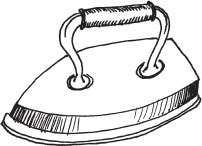
The theory is that the heat of the iron will melt the grease – on carpets as well as clothes – which will then be absorbed by the blotting paper. In practice, however, if you try this you need to be careful you don’t “cook” the mark and make it even more difficult to remove.
For washable clothes, the best way to get rid of grease marks (made by anything from mayonnaise to machine oil) is to rub them with liquid detergent then wash them with detergent in the hottest water possible. Pre-wash treatment with a proprietary stain remover may help, but be sure to test the fabric first to make sure that it is colourfast. Take anything that can’t be washed to the dry cleaners and highlight the offending areas for special treatment. For carpets and rugs, carpet shampoos are most effective, either for spot cleaning of grease stains or all-over cleaning.
Candle wax can be more easily scraped off if it is first hardened with a block of ice. The remains can then be given the hot iron and blotting paper treatment.
On grease, detergents are much more effective than soap because they not only act to emulsify the fat – break it up into minute droplets that will then lift off the fibers of a fabric – but, as they do so, attach themselves selectively to dirt. The first detergents were developed in Germany in the 1880s, and Nekal was the first brand name detergent, sold there in 1917. However in the days before detergents, another recommended method was to rub dry flour on a garment or carpet and to leave it for several hours to absorb any grease or oil. Turpentine was also used as a dry cleaner.
Natural beeswax from the hive is still one of the best polishes for keeping wooden furniture in great condition, although special finishes need other kinds of treatment.
Waxing and polishing furniture protects it and keeps it looking shiny and bright. It won’t need re-treating more than once or twice a year, depending on how often it is used. Once well waxed, with a bought or homemade polish (see below) it can be cleaned with a duster (aided if you wish by a proprietary dusting spray) or wiped with a barely damp cloth. Furniture finished with shellac, lacquer or varnish is better left unwaxed. Soapy water used sparingly on a soft cloth should remove all but the worst marks.
You can make a good all-purpose beeswax mixture at home by melting 2 tablespoons of beeswax granules with the same quantity of turpentine. Oak furniture that is stained or dull will take on a wonderful shine if polished with a warm mixture of 1 tablespoon of beeswax granules melted with ½ pint (300 ml) beer and 2 teaspoons of sugar.
Camouflage is the best way of dealing with scratches and other marks on furniture. Buy one of the “touch up” pens sold for the purpose or try a small amount of artist’s oil paint on a cotton bud or fine brush, or some cream shoe polish in a matching color applied in the same way.
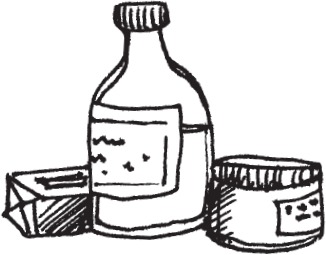
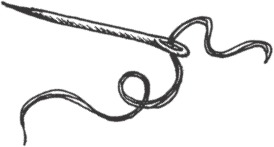
In the days before cheap clothes and hard-wearing artificial fibers, mending was a necessity. And until the late 20th century, home dressmaking was an essential part of “making do” for all but the wealthy.
Darning – especially of socks and stockings, which wore out quickly – was an almost daily necessity in the days before the invention of nylon and polyester. To make the task easier, a wooden darning ball, egg or mushroom was put inside and the area containing the hole stretched smoothly over it.
The first metal needles for sewing were made in the Middle East and brought to Europe in the 14th century. Early metal needles made in Germany in 1370 had a hook at one end to keep the thread in place.
With the ever-increasing demands of fashion, which reached their height in the late 1800s, came an even greater need for frugality. Mending was essential for a respectable middle class woman who needed six different outfits for just an ordinary day – typically a dressing gown, a “costume” or suit for shopping, a day dress (and an overall for kitchen work), an afternoon dress, a tea gown and a dress for dinner – plus all the extras to go with them, from trimmed bonnets to kid gloves.
Young married women would also make their husband’s shirts and stockings and the advent of paper patterns was a boon for the thrifty housewife. During the 19th century, women’s magazines produced patterns that needed to be copied and enlarged by hand from the page, but the big breakthrough came when the American tailor Ebenezer Butterick began selling ready-sized packaged paper patterns.
It was the combination of necessity and thrift that brought about the development of the crafts of quilting and patchwork. The oldest patchwork known was made in Egypt around 980 BC from a gazelle hide.
TURN YOUR MATTRESS ONCE A MONTH
The reasoning behind mattress turning is to prevent sagging in the areas where it bears body weight, but a clean mattress may be even more important for your health than a firm one.
Monthly turning, say many modern manufacturers, should be done only when a mattress is new, while it is settling into your body shape, and only occasionally thereafter, but only a mattress that is identical on both sides should be flipped over. If the top layers are different from the bottom ones – as in the “advanced foam” mattresses that mold to your shape with your body warmth – rotation is all that is needed.
A good reason why we need comfortable mattresses: when we are asleep we change our position, on average, four times an hour.
Firm, not overhard, support was the ideal supplied for centuries by horsehair, although the American housewife of 1896 could buy for $11.75 a cotton felt mattress “equal to an $18 mattress of the best hair.” From 1901 the luxury mattress had springs set inside. In the most superior types of today, hundreds of springs are sewn into individual pockets, enabling the mattress to support the weights of two individuals without the heavier person making it tilt.
Keeping a mattress clean, especially ridding it of the shed skin and dust mite debris that inevitably build up inside, is probably more important than turning, especially if you suffer from allergies. Light vacuuming – not beating – is the best treatment. If you have a garden, your mattress will benefit from an annual airing in the sun.
Straw is the oldest mattress filling – the Romans combined it with wool and feathers for added comfort – but dried pea pods were also used by the poor in the Middle Ages. This may be the origin of the fairy tale “The Princess and the Pea.”
CLEANLINESS IS NEXT TO GODLINESS
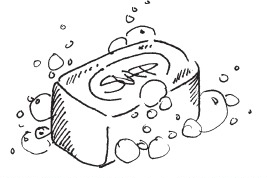
This mantra of the diligent housewife was first declared by John Wesley, the 18th-century founder of Methodism. In the same sermon he also declared neatness of apparel to be “a duty, not a sin.”
At the time of John Wesley’s pronouncement, cleaning was a daily routine that relied on elbow grease combined with a range of homemade materials including a paste of ashes, sand and grit for scouring, a polish for grates made from bone ash and charcoal, and a beeswax furniture polish. Soap was a luxury reserved for personal use, although surfaces might be scrubbed with lye, an alkali made from ashes. Cleaning was made more difficult by the clutter deemed necessary in the well-appointed middle class home and by the smoke from coal fires.
As to godliness, it is thought that Wesley’s saying came originally from an ancient rabbi, Phinehas ben Yair, and for the ancient Jews cleanliness meant much more than the absence of dirt. Washing was a religious ritual for, as it says in the Talmud, “Respect for God demands that the face, the hands and the feet be washed every day.” There were – and still are for devout Jews – many sources of uncleanliness, including foods such as pork, shellfish, and the blood of any animal.
This Victorian rhyme about laundry epitomizes the strong connection of the time between dirt and guilt:
They that wash on Monday
Have all the week to dry.
They that wash on Tuesday
Are not so much awry.
They that wash on Wednesday
Are not so much to blame.
They that wash on Thursday
Wash for very shame.
They that wash on Friday
Wash in sorry need.
They that wash on Saturday
Are last sluts indeed.
And of course no one would ever have contemplated doing their washing on a Sunday when they should have been at church!
A BOILED CORK WILL FIT ANY BOTTLE

This old tip works because boiling water softens the cork. Although it also makes it swell, the cork becomes malleable enough to be forced into a narrow opening. Modern winemakers soften sterilized corks in a mixture of glycerol and sulfur dioxide before they are rammed home.
The Romans used corks to seal their wine jars, but putting wine in corked bottles has been usual only since the late 17th century, when it was discovered that wine kept and matured much better this way than if left in the barrel. Winemakers of that time also quickly realized that bottles needed to be laid horizontally to prevent the cork from drying out; a dry cork lets in air, which oxidizes the wine and makes it vinegary.
Natural cork comes from the thick, protective bark of the evergreen cork oak (Quercus suber), native to the western Mediterranean. It is cultivated particularly in Portugal, which still supplies a large proportion of the market. What makes the cork such an effective stopper is the combination of a honeycomb of minute air cells (over half the volume of cork is empty space) and the waxy, waterproof substance suberin found in its cell walls. The structure of cork was first seen under the microscope by the English scientist Robert Hooke in the 1660s.
Another old tip for a cork that is a little too large for the bottle is to roll it on the floor and press on it with the sole of a boot or heavy shoe.
The increasing use of the plastic “cork” has as much to do with the incidence of corked wines – wines that are tainted with the chemical trichoroanisole, usually as the result of rotten or mouldy corks – as with the increasing scarcity and expense of the natural material. The screw-top bottle has now become a more convenient and acceptable alternative.
Keeping a cork in your pocket during the day, and under your pillow at night, is said to be an effective way of keeping cramp at bay. In the 19th century people even made protective garters of thin discs of cork sewn between silk ribbons.
NEW BROOMS SWEEP CLEAN
Another way of saying that change is a good thing, but for the housewife it is also a reminder that her cleaning utensils should be renewed regularly.
Appropriately, the broom shares its name with the flexible branches of the plants long used for cleaning (botanically the genera Cytisus and Genista) for it was these, as well as branches of birch and heather, and tufts of maize, that were probably employed to sweep the floors of early dwellings. Tied together, and with a handle added, bundles of these twigs became the besom.
The wooden broom with bundles of bristles glued into its head dates back to the 15th century, and was still vital to the cleaning repertoire long after the invention of the vacuum cleaner by the London engineer Hubert Cecil Booth in the early 20th century. Brush purchasers of the 1930s were advised to look out for the presence of “inferior mixtures” hidden in a broom. These, it was advised, should be identified “by placing the hand across the surface of the broom and noting the greater readiness with which the bristle will spring back when released, as compared with the less springy substitute.”

Dozens of old sayings relate to the buying and handling of brooms – apart, of course, from their use as transportation for both witches and their feline familiars:
 Brooms bought in May sweep the family away.
Brooms bought in May sweep the family away.
 If you set a broom in the corner, strangers will come to the house.
If you set a broom in the corner, strangers will come to the house.
 Lay a broom across the doorway to protect the house.
Lay a broom across the doorway to protect the house.
 Throw a broom to ward off witches.
Throw a broom to ward off witches.
 It is unlucky to put a sweeping brush on a table.
It is unlucky to put a sweeping brush on a table.
 A servant will not get her wages if the head comes off her broom while she is sweeping.
A servant will not get her wages if the head comes off her broom while she is sweeping.
REVIVE CUT FLOWERS BY DIPPING THE STEMS IN HOT WATER
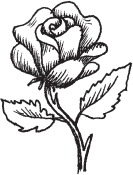
This shock treatment works for flowers with woody stems and some soft-stemmed blooms including dahlias, hellebores and anemones – and for roses limp at the neck. Afterwards, stems need to be left in cold water for a couple of hours before being arranged in a vase.
Flowers go limp because they lack water, often because air bubbles get trapped in their stems. Water at boiling point is recommended for this conditioning treatment; immersion for no more than 30 seconds pushes water quickly up the stems. Ideally, the flower heads and leaves should be loosely wrapped in a clean cloth to prevent them from being damaged by steam. For flowers such as poppies and euphorbias, which exude a milky latex, the recommended heat treatment is not boiling but singeing, to prevent the loss of fluid. Simply hold the cut end of the stalk in a candle or match flame until it is blackened and no more liquid oozes out.
Flower arrangers also use other ruses to help make flowers last longer. These include slitting woody stems and scraping off the bark, and submerging leaves (except grey furry ones) and stems in water for a couple of hours. Putting an aspirin in the vase with cut flowers can prevent wilting, because it has the effect of closing off the stomata, or pores, on the leaf surfaces through which water vapor naturally escapes.
To prevent indelible marks on valuable furniture, carpets and clothes, it is wise to remove the stamens of lilies before the flowers are arranged, although this reduces their heady scent and diminishes their looks considerably.
TACK WELL, SEW BETTER
In dressmaking, and other sorts of sewing, tacking, also known as basting, keeps the fabric in place before seams are stitched together permanently. Accurate tacking is always vital to the fit and finish of any garment, however simple.
After pieces of fabric have been pinned together the best tacking is done by hand, using a thread of contrasting color so that it is easy to see when it is ready to be removed. The ideal way to tack is to knot the thread at one end, and to make long stitches, bringing the needle out each time ¼–½ inch (6–12 mm) beyond the point where it was inserted. For permanent stiffening, dressmakers of the past would tack whalebones into garment seams before the final stitching was done.
Machine sewing then holds fabric pieces firmly in place. The earliest types, like that invented for sewing leather by the Englishman Thomas Saint in 1790, created chain stitches, which easily unraveled if the thread snapped. The breakthrough came with lockstitch, made with one thread above and one below the fabric. The lockstitch machine was invented in 1834 by Walter Hunt, but not patented until 1846 by the Massachusetts mechanic Elias Howe.
It is said that if you break a needle while sewing you should bury it in the ground as a precaution against bad luck.
In 1851 another American, Isaac Singer, made his own version, and although successfully sued by Howe for the patent, subsequently joined forces with him.
Before – and long after – the invention of the sewing machine, hand sewing was a social occupation, as it remains today. Once, women would routinely take their needlework when visiting friends and neighbors and the “sewing bee” existed as much for exchanging practical information, gossip and for storytelling, as for stitching.
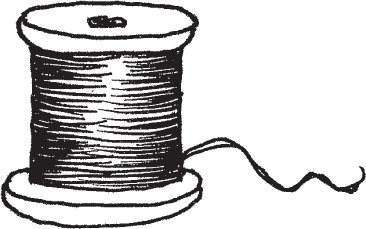
CLEAN WALLPAPER WITH STALE BREAD
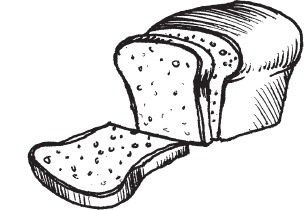
This old and effective method for fingermarks and light stains can even work on ballpoint marks when fresh. Almost stale – not totally bone dry – bread is best; it will also clean your hands, which is useful if you want to avoid getting them wet.
The cleaning is best done with the inside of the crust, which will not crumble and make a mess. If it doesn’t work, a soft pencil eraser may do the trick, but make sure it is spotlessly clean before you start. Modern waterproof wallpapers can be sponged with a barely damp cloth, but if you use detergent, test an area of paper that is well hidden to make sure that the color doesn’t come off.
For badly stained paper, try rubbing it with dry, medium oatmeal on a soft cloth.
Timeliness is important too, for as the American Lilian W. Betts advised in The Art of Housekeeping of 1896: “The longer the dirt or disfigurement remains, the more difficult it is to remove.” She also had sound advice on mending torn wallpaper, which still holds good: “Never put the patch on with a straight edge… Cut the edge in uneven scallops and points to match the figures [of the pattern] perfectly. Sometimes it will be almost impossible to discover the patch on the walls.”
Wallpaper evolved as a substitute for the thick wall hangings that decorated and helped to insulate homes up to the 19th century. Early papers of the late 17th and early 18th centuries were small, simple block-printed sheets, rather like tiles. Elaborate flocked designs, imitations of Italian silk velvet, were particularly desirable in grand Georgian homes, but wallpaper did not become affordable or popular until the 1840s, when it was first machine printed in two colors, using a technique adapted from calico printing.
DON’T STORE BISCUITS IN THE CAKE TIN
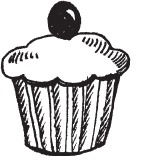
Moistness from any kind of cake will quickly make crisp biscuits, cookies and crackers go soft and soggy. The prudent housekeeper keeps biscuits and cakes in separate, airtight tins to guarantee their individual freshness and keeping qualities.
First, the terms. In Britain a biscuit is a snappy Rich Tea or Digestive, but in the USA it is something softer, similar to an English scone. The American cookie is the nearest equivalent to the British biscuit. In northeast Scotland “soft biscuits” are buns made from bread dough with butter and sugar added. The word biscuit comes from the Latin panis biscotus, which means “bread twice cooked.” Biscuits belong, as Mrs. Beeton says, to “the class of unfermented bread and are, perhaps, the most wholesome of that class.”
The simnel was originally a biscuit, not the fruit and marzipan cake we now associate with Easter. It was made from sweet dough that was first boiled, then oven baked.
Biscuits are not necessarily cooked in the oven. From the Middle Ages onwards, wafers were made by heating a thin layer of mixture on a heated plate, and even before that the Romans made deep-fried biscuits from what was essentially a sweetened pasta dough.
Ship’s biscuits, eaten for centuries by soldiers as well as sailors as their staple food on long journeys, were renowned for their keeping qualities and resistance to attack by insects.
FIT A CANDLE TO A CANDLESTICK: DIP IT IN HOT WATER
The simplest and easiest way to soften the wax and allow a good fit, it is also safer and more reliable than trying to melt the candle end with a lighted match or the flame of a cigarette lighter.
Soft candlelight provides a subtle evening ambience, but is no longer a necessity in the home. If a candle burns blue it is said that a spirit has entered the house.
The first candles were made by immersing rushes or flax fibers in animal or fish fat (tallow) or in beeswax. Even by the 1920s, when most towns and cities were lit by electric light, country housewives still saved their kitchen “scummings” for making tallow candles, which though economical gave out a yellow light and an acrid smell.
Candles improve with keeping. Left exposed to the air for a few months the wax hardens and will burn longer and brighter.
Most candles are now made from paraffin wax and machine molded. The best are made from spermaceti, the waxy substance found inside the head of the sperm whale.
A British Act of Parliament of 1860 defined a “standard candle” as one made of spermaceti wax, six of which together weighed 1 pound (450 g), and which burnt 120 grains of wax an hour. From this specification came the original measures of gas and electric light in terms of candle power.
The chamberstick, with a dishlike base and a carrying handle, was the candle ‘to light you to bed’. Designed in the 17th century, it changed little for another 200 years.
REMOVE WATERMARKS FROM FURNITURE WITH MAYONNAISE
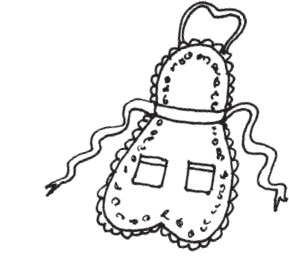
This can work on light marks by drawing the water out of the wood, but is by no means infallible even if, as some experts recommend, you mix in a little cigarette ash or toothpaste.
Even if this method proves effective – and you need to rub the affected area gently for half an hour or more so that the oil in the mayonnaise can work into the wood, or leave the mixture in place for 12 hours before buffing – you may still have a problem. Because both ash and toothpaste are abrasive they can ruin the piece’s finish. A final, thorough waxing may help, but the bottom line is that water in any form, including wine, is bad for polished wood and a valuable piece may need professional restoration.
To prevent problems, protect your table with coasters. These were invented in the 1760s to avoid wine spillages on furniture and linens and were originally made from silver or Old Sheffield plate. They were not flat like modern coasters, but like shallow dishes, initially quite plain but by the early Victorian period intricately decorated. Coasters got their name from the (male-only) after-dinner custom of rolling back the tablecloth and coasting – sliding – the port, placed in its smooth-bottomed container, from drinker to drinker.
Heat can also damage furniture. Placing a veneered piece next to a radiator can make it too warm and draw the natural moisture from the wood, causing the surface to rise up and cockle.
DON’T FORGET TO DUST YOUR HOUSEPLANTS
Dust is not only unsightly but clogs the stomata, or pores, in the leaves through which plants “breathe.” But plants in modern homes fare better than those in stuffy Victorian parlors.
When treating indoor plants, use a clean cloth and wipe large, glossy leaves individually; more feathery leaves are best sprayed with water. Don’t waste money on proprietary cleaners; if used too frequently they can also clog the pores.
The need for houseplant cleaning reached its height in the Victorian period, when plants such as the aspidistra – nicknamed the cast iron plant for its sturdy resistance – were grown in living rooms thick with smoke from gaslights and open fires, and dust from heavy hangings and furniture coverings.
After a death in the family, an old custom was to tie lengths of black crêpe (a type of crinkled silk) around indoor plants to prevent them dying too.
To protect them from pollution, 19th-century householders would grow ferns, which were all the rage, enclosed in glass Wardian cases. These were effectively miniature greenhouses, containing their own self-sustaining microclimate. They had been invented by the London doctor and ardent naturalist Dr. Nathaniel Bagshaw Ward. In 1833 he filled one of them with ferns, grasses and flowering plants; it subsequently survived the journey from Britain to Australia. On the return journey, Australian specimens filled the case and arrived “in the most healthy and vigorous condition.”
TIPS TO KEEP HOUSEPLANTS ALIVE
 Don’t overwater plants, especially in winter.
Don’t overwater plants, especially in winter.
 Let the compost dry out between waterings.
Let the compost dry out between waterings.
 Deadhead faded flowers.
Deadhead faded flowers.
 Remove dead or yellowing leaves.
Remove dead or yellowing leaves.
 Feed plants in their growing season, usually spring to autumn.
Feed plants in their growing season, usually spring to autumn.
 Avoid wetting the furry leaves of African violets.
Avoid wetting the furry leaves of African violets.
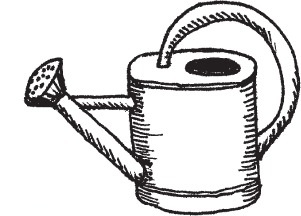
TO GET YOUR WASHING WHITE, DRY IT IN THE SUN
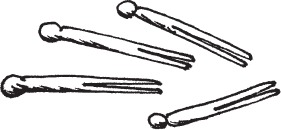
Oxygen and ozone in the air work as bleaches that not only whiten but disinfect the wash – not to mention the added benefit of the wonderfully fresh aroma of sundried linens. On the downside, washing left outside is at the mercy of the weather.
If there is a light breeze, hanging the washing outdoors can also help remove creases from clothes and cut down on ironing. However thick items like towels can get hard and stiff when dried in the sun, and may be better finished off in a tumble dryer or airing cupboard.
There is an art to hanging out the washing. First you need to choose what to pin out: woolens, silks and delicate fabrics are better kept indoors and dried flat. It would have been second nature to the laundry maid to peg socks by the toes, shirts by the tails and dresses by the shoulders. Adjacent tea towels and handkerchiefs she would have pegged together at the corners, making a neat, firm row on the washing line.
For securing items such as sheets and jeans so that they don’t blow away there is still nothing to beat the traditional push-on American peg, or clothespin, made from a single piece of wood. This is not only durable but, unlike the spring-grip peg (which comes in plastic as well as wood and is most suitable for more delicate items), has no metal to rust. The gypsy peg, rarely seen nowadays, is made from two pieces of whittled wood held together at one end with a band of metal.
In seafaring communities, wives will never wash clothes on the day their menfolk set sail, for fear that this will wash their ships away.
CLEAN BOTTLES WITH EGGSHELLS
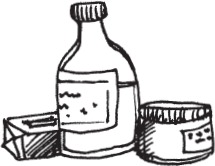
When marks are inaccessible with a brush, crushed eggshells shaken inside a bottle or decanter with warm water and a little washing-up liquid make an excellent and effective cleaner.
Alternatively, you can buy boxes of “magic” metal balls that do the same job by abrading the inside of the bottle. These are the modern version of the lead shot that butlers traditionally used in decanters, with the addition of brandy. Coal ashes shaken with hot or cold water are another old-fashioned cleaner.
Eggshells have other good uses. Crushed and spread in the garden they can help to keep slugs off your most vulnerable plants. In the kitchen they can be used to clarify consommés; the cloudy particles in the liquid cling to the eggshells, which can then be filtered out.
Since the 18th century wine bottles have been molded into identifiable shapes for specific wine regions and grapes, from the “shouldered” Bordeaux bottle to the squat, round one for Chianti.
The shell of a hen’s egg is 95 percent calcium carbonate and is secreted around the yolk and white by the hen’s shell gland in a process that takes about 14 hours to complete. It is traditional chicken-farming practice to add crushed eggshells to the birds’ feed to provide the minerals they need to make fresh shells.
PUT WHITE WINE ON A RED WINE STAIN
Red wine on a pale carpet or favorite sweater is the accident everyone dreads, but white wine is better drunk than wasted on a stain! Salt may work to a degree (and is good for bloodstains) but a mild detergent is by far the best remedy.
When poured on to a stain, the bubbles in soda water can help to lift a red wine stain from carpet or fabric fibers, but whatever remedy you choose, haste and a gentle touch are essential. Your aim should be to prevent the stain from “setting,” spreading or being rubbed into the fibers. The advantage of the detergent approach is that you can whiz up a foam that can be palmed on to a carpet to work on the stain without getting the pile soaking wet. The residue can then be carefully removed with a clean cloth, without rubbing, and the area neutralized with a dilute solution of white (not wine or malt) vinegar.
To remove wine stains from linen, common 19th-century advice was to hold it in milk “while boiling on the fire.”
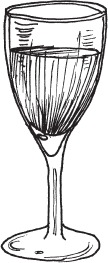
OTHER GOOD TIPS FOR SPILLS AND STAINS
Coffee and tea – detergent followed by vinegar, as for red wine. Chewing gum – put a bag of ice cubes on the offending area, or put a garment in the freezer for at least an hour, then scrape off the hardened gum.
Ink, oil-based paint, butter – commercial dry cleaning fluid, followed by diluted household ammonia.
Blood, egg, milk, chocolate – detergent in cold water (to avoid cooking the stain), then vinegar diluted in water.
